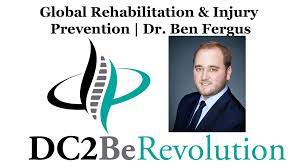An Interview with Dr. Ben Fergus
When I was a chiropractic student, I interviewed one hundred chiropractors for the DC2Be Revolution YouTube channel and podcast. This article is about the insights I gained from Dr. Benjamin Fergus. He’s the clinical director at Cornerstone Health in Evanston, Illinois and the founder of global rehabilitation and injury prevention seminars.
- Mentors for working with complex and chronic conditions
I’ve always been interested in learning about different avenues for treatment and diagnosis. That kind of thinking led me to Dynamic Neuro Muscular Stabilization (DNS) at the Prague school of rehabilitation hospital in the Czech Republic with founders like professor Karel Lewit, Vladimir Janda and Patel Kolar.
I would combine that with neurodynamics, pain science, and others. Synthesizing each one and looking at where each pathway said the same thing in their unique way. Looking for convergence between chiropractic, pain science and rehab. Eventually I stared to create my own framework based on the work of these giants. This has allowed me to work with complex and chronic cases.
- How to provide a quality second opinion
Most of our patients been to one or more medical doctors, chiropractors, and physical therapists before coming to see us. We provide them a detailed second opinion. Once we evaluate them I say “I know you’ve had lack of success with treatment methods in the past, but since that time we’ve learned a lot more about the way the body works and we’ll use that for your treatment.” Patients are enthused by having a potential new option for resolution. Integrating the literature into practice happens on a one-to-one basis first. Then it happens on the back end when our team of doctors discusses a case. We look at the presentation, the traditional ways of treating, what didn’t work, and where we can access new information in order to provide improvement for this person.
- How to work with complex cases
Do what’s right for the patient. Know what their needs are and what’s worked for them in the past. Understand what they fear and what they’re comfortable with. They’re often seeing you on one of the worst days of their life. You must first understand the psychosomatic’s behind their pain. After this, make PubMed your friend. Get on PubMed and use the keyword searches. Identify different categories of pain and different categories of muscle or nerve dysfunction. Understand the different categories of dysfunction and be able to identify them.
- How to evaluate complex cases
Use a movement assessment that looks at the body in a single plane of motion at a time. When performing an evaluation on an individual, I want to ask does the brain, peripheral nervous system, muscles, joints, etc. work together for a specific movement in a single plane of motion? The assessment is palpating the brain’s ability to control the body. We’re essentially asking the central nervous system, “Can you move this joint complex into three planes of motion?” If you’re stuck in one plane, how does your body compensate for that? Where do you steal movement, or steal muscle activity, or endurance etc? It leads to strategies for correcting loss of motion that are reliable.
- How to diagnose complex cases
Our promise to our patients is that nobody’s going to look deeper. We’re going to do a better evaluation. We’re going to give you as much information as we can. Once we know what is going on we are going to provide effective treatment based on quality diagnosis.
To watch the entire interview, you can go here. https://www.youtube.com/watch?V=0ikv6olvje4
Noah Volz, DC is the author the The Master Student: Book 1: Mindset: The Ultimate Guide to Success, Enjoyment and Productivity as a Chiropractic College Student.

